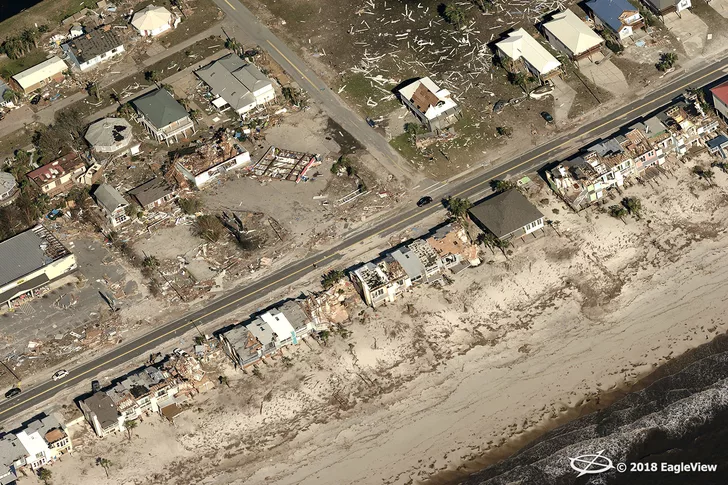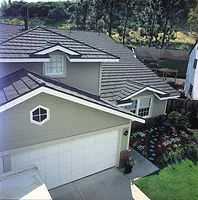8 Hurricane Preparedness Tips to Share with Your Customers

Damage caused by Hurricane Michael.
Hurricanes are no joke when it comes to causing property damage, but roofing contractors can help their communities prepare ahead of time to mitigate damages and injuries.
OSHA states if a hurricane becomes a Category 3 or above, catastrophic damage can be expected as winds ranging from 111 mph to 157 mph or higher ravage cities or entire states. Expect everything from uprooted trees and utility poles to roofs being peeled from their buildings. Even a Category 1 hurricane can generate 95 mph sustained winds that can cause severe damage to their roofs.
To help property owners endure these extreme conditions, the National Roofing Contractors Association (NRCA) and roofing contractors that have dealt with hurricanes have provided tips that can be shared with consumers. In doing so, roofing contractors can help ensure the recovery process is as smooth and safe as possible.
1. Stay Safe
This seems like an obvious tip, but it never hurts to remind people to be cautious when severe weather is on its way. For instance, CNN reported the tragic news of an 80-year-old man who died from falling off of his roof while preparing for Hurricane Dorian.
Remind customers that inspections should be made by professionals if a ground-level inspection cannot be performed. The same goes for making repairs. As the NRCA explains:
“Except in extreme situations, do not attempt roof system repairs. The puncturing of a blister (shingle expansion caused by trapped gases such as air or water vapor) or the spreading of a coating or mastic covers up evidence a roofing contractor needs to ascertain the problem. Roof openings should be temporarily covered with tarpaulins to minimize rain damage.”
While it’s important to properly prepare for a storm, the top priority should be to stay safe and follow instructions from local officials about evacuations and shelters. If an evacuation order has been issued, suggest that property owners take it seriously. Property can be replaced, but a life cannot.
2. Double-Check Your Gutters
As Florida-based Universal Roof and Contracting explains in a Facebook Live video, making sure a home’s gutter system is clean and free of debris will help keep water from damaging a home due to overflows.
Part of this check should include removing any current debris or foreign objects from the roof itself. Anything from toys that ended up on the roof to branches can enter and clog the gutter. Again, safety is a must, so offer this service to consumers if able.
3. Trim Trees and Shrubbery
In addition to checking gutters, property owners should inspect any potential plant life that could cause damage when enduring hurricane-force winds. Best Roofing in Fort Lauderdale, Fla. created a checklist that reminds property owners to keep their trees trimmed, as overhanging branches could easily snap and damage a roof.
4. Note the Home’s Condition Prior to a Storm
Calloway Roofing in Orlando suggests that consumers document the condition of their property prior to a storm. Take photos of everything, including a picture of the entire property from a distance as well as close-ups of mailboxes, windows and rooms. Snag photos of the roof at various angles by zooming in from a distance.
If a home already has damage like ceiling stains, Universal Roof and Contracting told customers to mark the outline of the stain with a pencil or pen. If it is caused by water damage due to a leaky roof, the stain will move past the lines and indicate repairs need to be made.
5. Get Insurances in Order
Calloway Roofing has another great tip for property owners: Find your insurance policy and place it in a sealable, clear plastic bag. Do the same with any warranty information, such as a roof or solar panel warranties.
The NRCA suggests property owners should prepare by gathering copies of their homeowner’s policy or tracking down policy numbers to have should they need to call their insurance company to assess any damages. The NRCA further recommends having a roofing contractor conduct a similar assessment in addition to the insurance adjuster’s assessment of roof damages.
Best Roofing reminds homeowners that, if they haven’t done so already, they should consider adding flood insurance to their coverage, as most homeowner’s policies do not cover hurricane-related floods.
6. Shut Off Utilities
Before leaving a property, FEMA recommends turning off the home’s electrical power, natural gas and propane utilities. This can prevent any damage from becoming worse, as it avoids causing fires or explosions.
If homeowners are unable to do so before the storm, they should definitely shut off any utilities afterwards if they suspect their home is damaged. If they see frayed wires or sparks, shut off the electricity. If they smell gas, shut it off and open windows to air out the home.
Much like they should contact a roofing contractor for roofing needs, consumers should contact their utility companies or emergency services if they suspect their property is in danger.
7. Beware of Unprofessional Contractors
As CMR Construction & Roofing in Texas warns, there are many unsavory individuals and businesses who will try to take advantage of dire situations to “maximize profits without considering the satisfaction and safety of their clients.”
Per the NRCA, the following are a few aspects that professional roofing contractors should have to assure customers they’re the right people for the job:
- A permanent place of business
- Knowledge of various roof systems
- Proof of insurance and an effective safety program
- A license and/or be bonded
- Warranties
- Evidence of industry professionalism, such as proof of training or certifications
As a roofing contractor, there are steps to take to ensure you’re connected to homeowners. For instance, Florida has the Disaster Contractor Network, where licensed contractors can register to help protect consumers from unlicensed contracting practices.
8. Schedule Annual Evaluations
If a homeowner or business is located in a hurricane-prone area, yearly evaluations should be on their list. As a general practice, remind customers that yearly inspections will help keep a roof system in top shape for when extreme weather appears. Best Roofing tells its customers that the spring and fall are the best times, as they are before and after hurricane season.
If you have a story idea as it relates to the roofing industry and hurricanes, we want to hear from you. Email Managing Editor Chris Gray at grayc@bnpmedia.com.
Looking for a reprint of this article?
From high-res PDFs to custom plaques, order your copy today!








